닫기
- About Us
- Sustainability Management
- Wholesome Foods & LOHAS
- Newsroom
LOHAS
“LOHAS is about loving people and nature.”
Pulmuone exemplifies the principles of LOHAS and aspires to achieve harmony between
healthy people and a healthy environment by epitomizing love for our neighbors and respect
for life embodied in the LOHAS philosophy. Reckless destruction of our ecosystem and ever
worsening environmental pollution are threatening the sustainability of our global community,
and it is time to ponder over what small steps we can take in our daily
lives for the betterment of the next generation.
We at Pulmuone seek to promote healthy lifestyles that allow for coexistence with nature and to propose ways to enjoy sustainable living. As your interest in how we live and eat deepens, turn your eyes to the LOHAS Diet and LOHAS Living, as recommended by Pulmuone.
We at Pulmuone seek to promote healthy lifestyles that allow for coexistence with nature and to propose ways to enjoy sustainable living. As your interest in how we live and eat deepens, turn your eyes to the LOHAS Diet and LOHAS Living, as recommended by Pulmuone.
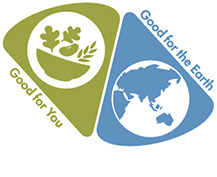
What’s good for your health is also good for the environment. Pulmuone has designed the LOHAS Diet Model to realize LOHAS Living, expanding our concern from food safety and dietary balance to our environment. To reduce our carbon footprint from the perspective of LOHAS Living, we are planning on adjusting our production based on the pre-analysis of carbon emissions related to our products and services. By lowering carbon emissions from the development stage for products and services as well as in our workplaces, we hope to protect the Earth’s environment along the entire process of manufacturing, distribution, and consumption.
LOHAS Diet Model for Health and the Environment
For health and the environment, Pulmuone recommends the LOHAS Diet Model. The model, which improves both our health and the sustainability of our environment, is designed to demonstrate that healthy foods are also beneficial to the Earth’s environment and to put that knowledge into practice. How about experiencing the LOHAS Diet Model for yourself, and then sharing it with others?
LOHAS Diet Model
LOHAS Dietary Model for Children
Children are recommended to consume 1,400kcal per day to promote growth and remain healthy.
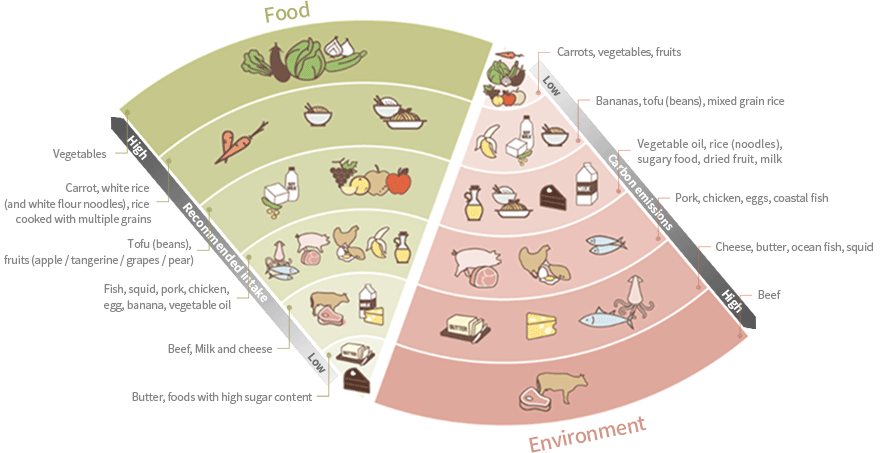
· White rice with less dietary fiber content is recommended instead of whole grains as children’s ability to digest is not fully developed.
· Fruits with high sugar content are not categorized separately as fruit as a whole is a valuable, irreplaceable source of nutrition.
· The recommended intake of milk and cheese for children is one level higher than that for adults to ensure a sufficient level of calcium required for proper growth.
LOHAS Diet Model for Adults
The diagram of the LOHAS Diet Model is shaped like two folding fans put together with one facing upward and the other facing downward. The left part lists foods in descending order from the top in terms of the amount of recommended intake. The right part lists foods in ascending order from the top in terms of their carbon emissions. For instance, on the left-hand side, the foods with the largest volume of recommended intake are vegetables. On the right-hand side, however, the diagram indicates that fruits and vegetables produce the fewest carbon emissions. We can thus confirm that healthy foods have less of a negative impact on the environment.

※ To prevent chronic disease and enhance health, adults should consume 1,800kcal a day.
The LOHAS Diet Model suggests different foods and calorie intakes for people of different ages, so please read our recommendations carefully.
LOHAS Dietary Model for Seniors
The dietary model for seniors 75 years of age and older is aimed at helping them lead a longer, healthier life. Seniors are recommended to consume 1,600kcal per day taking into consideration a decline in their ability to digest and absorb nutrition and in their physical activity.

· As for children, white rice, which has less dietary fiber and thus is easily digested and absorbed, is placed in the same section as rice cooked with whole grains.
· The recommended intake of fruit is lower as seniors burn less calories due to reduced physical activity and as fruit is high in sugar.
· It is recommended to get protein from vegetable sources rather than from animal sources as seniors burn less calories and require a reduced intake of animal fat.
Carbon footprints from Farms to Your Table: Apples vs Beef
What’s good for your health is also good for the environment. Carbon is released in the entire food chain starting from farms all the way to our kitchens. Altering cultivation methods (conventional farming vs organic farming), the source of energy in factories (fossil fuels vs renewable energy), and packaging methods (package materials and weights) can also reduce carbon emissions.
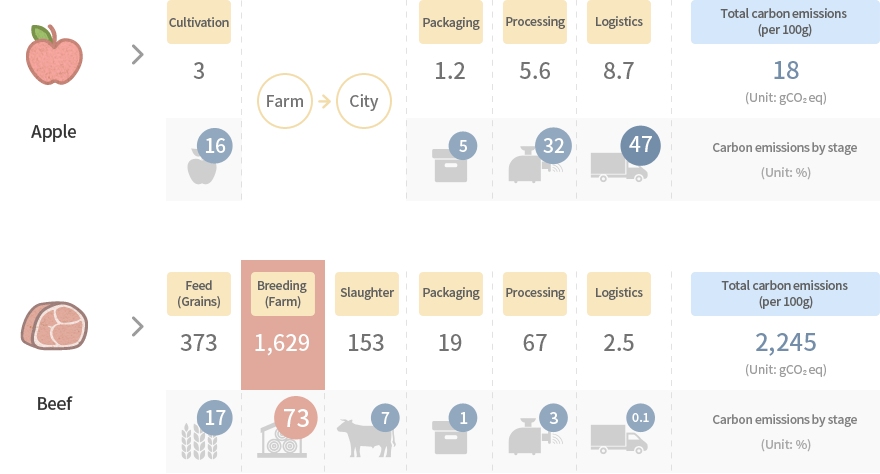
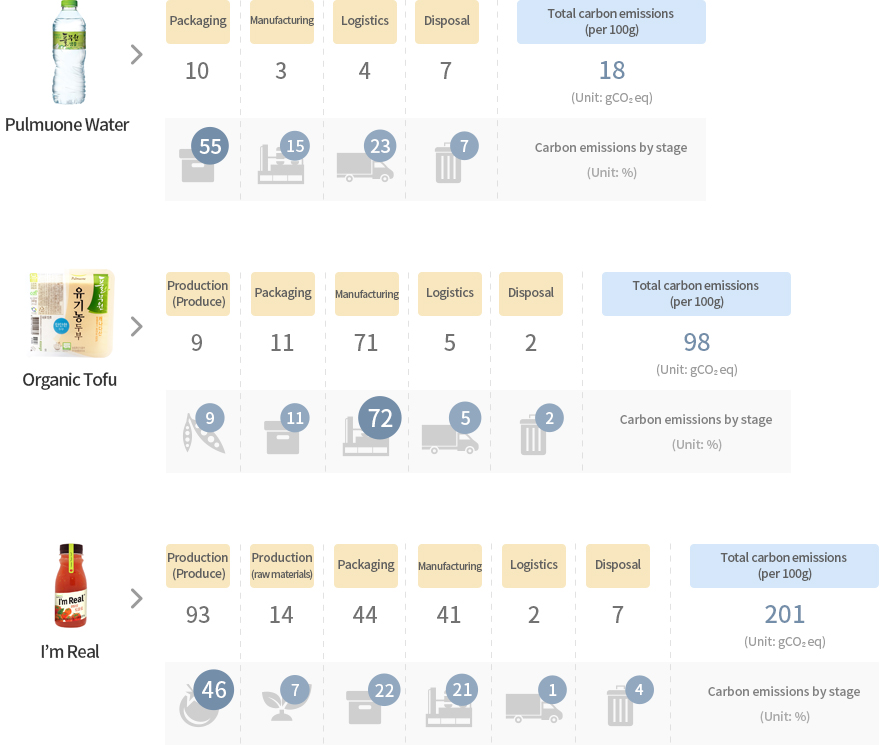
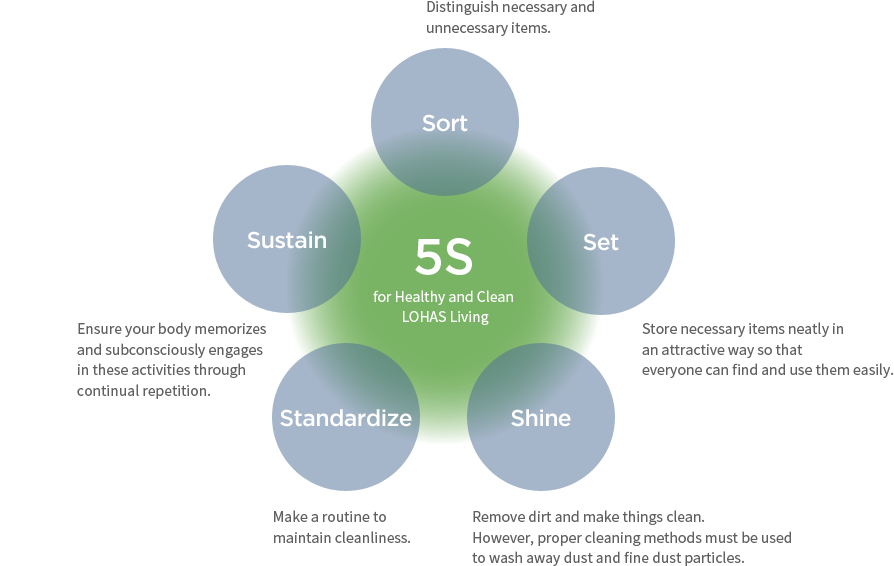

Pulmuone’s Carbon Footprint: Pulmuone Water, Organic Tofu, and I’m Real
To put into practice the LOHAS Diet Model and enhance both our health and the sustainability of our environment, Pulmuone strives to measure and reduce carbon emissions produced in the entire process—from production, packaging, manufacturing, and logistics to consumption and disposal. We will continue to expand such efforts to cover more of our products and post the changes we make on our website.

5S Activities
Pulmuone believes that the basis for LOHAS Living is to improve our environment by changing our daily habits. Did you know that saving water and maintaining clean air at home as well as sorting and decluttering can improve the environment? Making our daily living space neat and clean is as important as reducing greenhouse gas emissions for the Earth’s environment. To establish daily habits for the LOHAS Living, Pulmuone recommends the 5S Activities for neat and clean living and has launched Good Cleaning Class, a LOHAS Living education program for children. By participating in various games and experiential activities, children in the program are developing the habit of cleaning voluntarily and happily, while realizing cleaning can be a form of play and not a chore. The cleaning habits of our children are now spreading from their desks and rooms across our houses and around the globe!

How to Practive 5S at Home
- 1 If an item doesn’t tug at your heartstrings anymore, throw it away.
- 2 Arrange items based on your own rules for storage, disposal, and donation.
- 3 Find the right place for your items and store them there.
- 4 Put name tags on storage boxes to help you figure out what’s inside.
- 5 Open the windows and get some fresh air at least twice a day for 30 minutes.
- 6 Choose one area per day and clean it for 10 minutes.
- 7 Set a cleaning route. For instance, start from your bedroom, then move onto the living room and bathroom.
- 8 Establish weekly, monthly, and seasonal cleaning routines for your home. For example, clean mats once a day, and remove stains from window frames on rainy days.
- 9 Divide cleaning areas and roles among family members
- 10 After cleaning, enjoy the neat and pleasant vibe and praise each other










